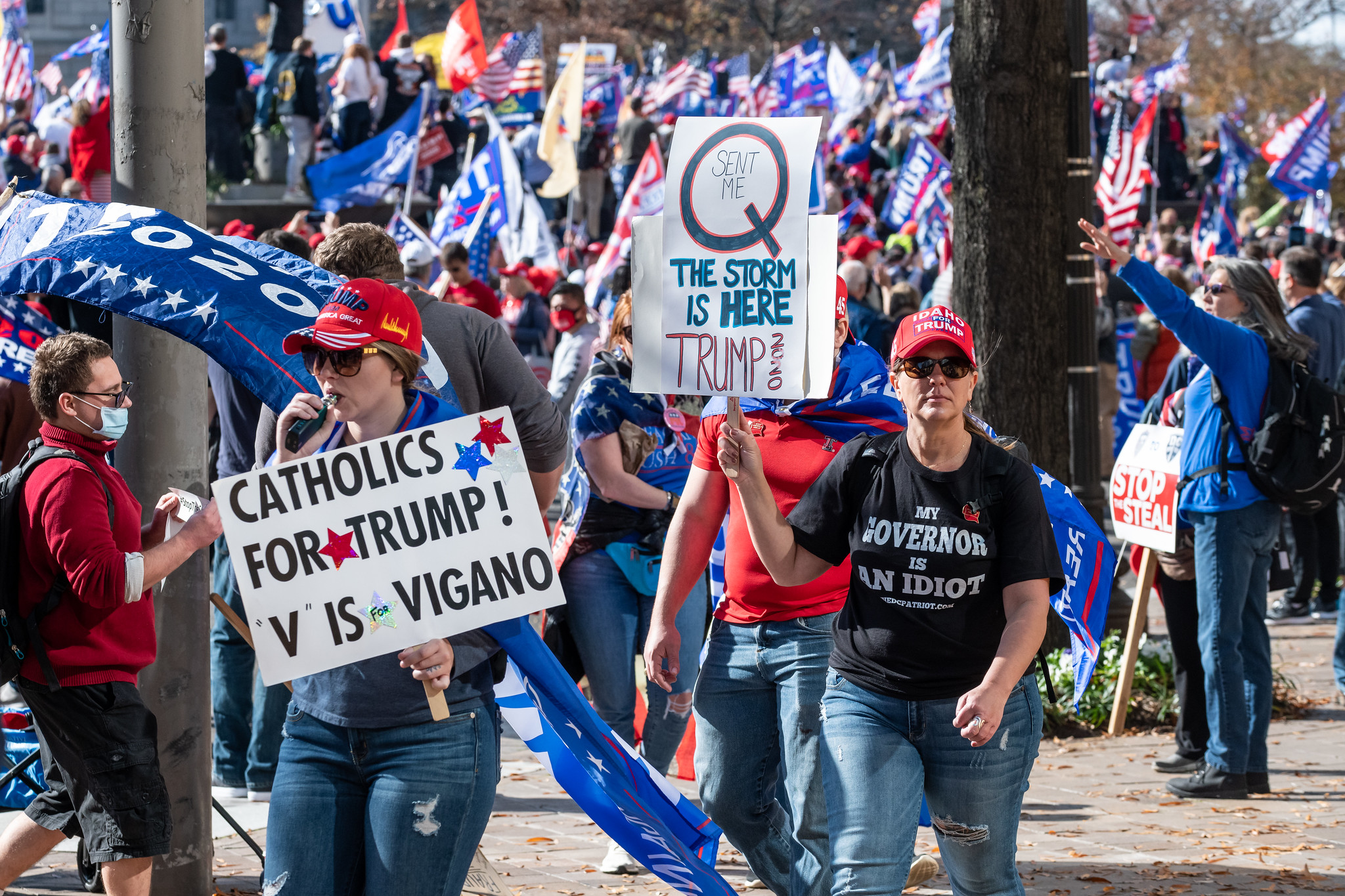This Obscure Tax Law May Be Hampering Efforts to Understand Domestic Extremism
In 1998, the IRS was prohibited from designating sovereign citizen nonfilers as “illegal tax protesters.” Two decades later, this provision may now be obscuring a plausible tool for identifying domestic extremists.

Published by The Lawfare Institute
in Cooperation With

In 1998, the 105th Congress passed the IRS Reform Act, which included within it a little-reported prohibition on the IRS’s practice of designating sovereign citizen nonfilers as “illegal tax protesters.” But two decades later, the provision has gained new relevance as sovereign citizen ideology has taken root among many domestic extremist groups. And that 1998 prohibition, which got so little attention when it was signed into law, may now be obscuring a plausible tool for identifying domestic extremists.
The sovereign citizen movement is a loosely organized group of individuals who do not believe they are subject to government statutory authority. Rather, they believe only in the legal authority of their own, conspiracy-driven, interpretations of common law. The movement has also played a notable role in the recent surge in domestic extremism. The movement’s theories offer a gateway to other political conspiracies, and some members of the movement were early adopters of QAnon. A trip—or rather, a click—down this path has the potential to lead to violence. Examples include the sovereign citizen roots in the Pizzagate shooting in Washington, D.C., and descendant extremist movements like the Three Percenters, a terrorist group with ties to the Jan. 6 insurrection.
Because sovereign citizen adherence is in some cases associated with actual violence, it may be useful to find tools that the government can utilize to identify individuals who ascribe to the sovereign citizen ideology, thus flagging a potential indicator of violent extremism. Because the “illegal tax protester” designation may reveal sovereign citizen adherents whose ideology motivated their protest, the designation could serve as a potential proxy for identifying individuals with a propensity for violent extremism. But, thanks to Congress’s prohibition on the IRS’s use of the designation, we cannot know whether such a proxy would be meaningful.
A 1983 estimate by the IRS commissioner put the number of illegal tax protesters at between 40,000 and 60,000. Today, the Southern Poverty Law Center estimates that that number has grown to at least 500,000, at least in part due to growth in the sovereign citizen movement. While there is no way to be sure, evidence linking domestic extremism and sovereign citizen adherence offers the possibility that today’s rise in extremism may have paralleled, or even followed, an uptick in tax protest claims.
The IRS’s use of the designation dates back to the 1970s, in response to “significant” growth of the sovereign citizen movement. The designation was assigned to individuals and businesses that protested tax laws on legally invalid grounds. The original reasoning for creating the designation was twofold: first, to alert IRS employees to use caution in order to avoid heightened confrontations with taxpayers and, second, to accelerate certain tax enforcement actions. Historically, the IRS identified these tax protesters when their tax returns or correspondence contained “specific indicators of noncompliance ... such as the use of arguments that had been repeatedly rejected by the courts.”
The use of absurd legal arguments to offer a façade of credibility is a defining feature of the sovereign citizen movement—examples abound in the derivative anti-mask and anti-vax movements. Just recently, a Jan. 6 defendant used her sovereign citizen beliefs to explain at a hearing that she “do[es] not stand under the law” of the United States because she was appearing as a “living soul” as opposed to as a “person.” Multiple Jan. 6 defendants have also signed their government filings with a red-ink thumbprint—a classic example of the type of sovereign citizen signals seen in tax filings that would catch the attention of an IRS employee.
Concerns with the designation stretch back to a 1983 Senate hearing on the Church Audit Procedures Act, during which Republican senators expressed concern about the IRS’s auditing of churches and advocated for more stringent regulation of those audits. At the time, tax protesters were attempting to evade liability by establishing sham church entities and couching their political theories as protected religious beliefs. Although the primary focus of the hearing was not on audits of illegal tax protesters, the overlap between that designation and religious liberty defenses raised alarm bells in conservative circles, which feared that any church-related entity could be targeted for ideological reasons—despite no evidence of the designation’s use in this manner.
During the hearing, a civil liberties lawyer made the case to senators that the guidelines for the designation were “vague” and that “[t]he very idea that the tax collector ... would devote special time to ... those who specifically protest against the activities of the investigator should raise the hackles of a defender of the First Amendment.” But this testimony failed to account for the fact that the IRS’s role is to investigate tax violations, and that the individuals designated as illegal tax protesters showed a heightened interest or obvious attempt to avoid paying taxes.
In another hearing before the Senate Finance Committee, a former IRS historian testified that the decision to assign the designation should face greater transparency, citing unverified concerns that taxpayers could face abuse. These claims were never verified, and the historian was banned from IRS offices after a controversial end to her career there. But the historian’s allegation, as well as her inflammatory analogization of this purported abuse to the since-disbanded Special Services Staff, a secretive IRS unit that was notoriously associated with the Nixon administration’s politicization of government agencies, was influential.
Congress passed legislation prohibiting the use of the “illegal tax protester” designation soon after. In fact, the prohibition made for a comparatively mild action to take at a time when candidates in Republican politics went as far as calling for the outright abolition of the IRS. Between the overarching distrust of the agency, the importance of the bill’s bipartisan victory, and the subsequent Clinton impeachment, the prohibition was passed and implemented with seemingly little debate.
The prohibition itself is broad. It eliminates the IRS’s ability to use both the designation of “illegal tax protester” and “any similar designation” as a tag on an individual’s IRS file. This prevents the IRS from filtering their files to compile data that could serve as indicators of how many individuals have fallen under the spell of these conspiracy theories. Further, some observers, including the IRS’s own inspector general, believe that the prohibition covers the use of this language in all circumstances—even as employees simply write case narratives that describe an individual file and contextualize a nonfiler’s attitude for future interactions. The impact of these unclear standards is seen in annual audits dedicated to ensuring the prohibition’s enforcement, which consistently find a small number of instances in which language is deemed to fall under the prohibition. Flagged examples include terms like “constitutionally challenged” and “frivolous constitutional.”
Not only has the breadth of the prohibition led to confusion, but it also leaves the IRS without the ability to construct useful alternatives with similar potential to track the size and growth of sovereign citizen ideology—and, potentially, the size of the breeding ground for individuals who could one day follow in the footsteps of those before them and commit acts of domestic terrorism. Other available designations, such as “nonfiler,” “frivolous,” or “potentially dangerous taxpayer,” are not tailored narrowly enough to act as reliable indicators of sovereign citizen beliefs.
Today’s threat environment is also far different than it was in the late 1990s. The United States’ primary terrorism threat is shifting from foreign to domestic, driven in part by individuals who traffic in the very protest arguments that the IRS is prohibited from designating. Meanwhile, this blind spot is evidenced by none other than sovereign citizens’ own celebration of the term’s prohibition, as seen in The Great IRS Hoax: Why We Don’t Owe Income Tax—a 120-page document created by a sovereign citizen group that has been targeted by the Justice Department. The document outlines dozens of legal arguments that would seemingly fall under the previous definitions of “illegal tax protest.”
Further, the emphasis on cross-government coordination and information sharing has vastly improved. In fact, the “whole-of-government” approach is now considered to be a cornerstone of policy across a number of issue areas. In March, the White House released an Interim National Security Strategic Guidance, which emphasized a commitment to “work as a coordinated, unified federal government to use the full array of tools at our disposal” and that “information sharing[] will be critical to understanding and addressing the broad spectrum of violent extremism America confronts today.”
With the White House’s words in mind, strict limits on the use and sharing of federal tax information (FTI) strongly influence the specifics of what a renewed “illegal tax protester” designation would look like, should the sovereign citizen links to violent extremism prove strong enough to inspire a reconsideration of the prohibition. The disclosure of tax information—which includes IRS-created files on taxpayers—is governed primarily by 26 U.S.C. § 6103, and, by default, tax information is confidential. But there are several disclosure regimes that could be utilized in this case.
The first applicable regime is § 6103(f)(1) disclosure to congressional committees. The IRS can disclose any non-individualized FTI (meaning it can’t be traced to a single individual) to the Ways and Means Committee, Committee on Finance, and Joint Committee on Taxation in response to a written request from the chair. The “illegal tax protester” designation data could then be made public by way of the congressional record. Only individualized FTI must be provided in a closed session.
The second relevant regime is § 6103 (i)(3)(C), which concerns matters of terrorism. Through this regime, the treasury secretary can disclose non-individualized FTI that is relevant to a foreign or domestic terrorist threat to the head, or officers and employees, of the appropriate federal law enforcement agency (or intelligence agency, as per (i)(7)(B)). The relevant agency must simply make the request and offer reasons as to why the disclosure would be relevant. However, this regime could create added civil liberties pressure on the designation’s own requirements because of the subsequent explicit labeling as a potential terror threat. Additionally, there is no clear path that would allow the receiving agency to share that data with the public or other partners.
Finally, public FTI disclosure most frequently occurs using the authorities under 26 U.S.C. § 6108 for statistical publications and studies. The treasury secretary can, upon request from any party, make special statistical studies and compilations involving return information. IRS guidelines explain that the information compiled under § 6108 authority must be presented in unidentifiable form; and the Statistics of Income (SOI) office, which carries out the approved research, has the right to release any study or compilation in addition to delivering it to the requesting party. In the past, research published by the SOI office has ranged from topline numbers on the wealth of the population to deep dives into taxpayer compliance and the driving factors of noncompliance.
It is also worth noting that a compilation of the designation’s use is already published annually by way of the authorities given to the inspector general’s office. While the authorities would need to shift, the resources and know-how for the process itself already exist—albeit for the purpose of showing how effective the prohibition is, as opposed to tracking how many illegal tax protesters exist.
Using existing regimes would have the benefit of avoiding the tedious process of Congress, the controlling body for disclosure, writing and passing new language. But repealing the prohibition would require an act of Congress, allowing for the opportunity to create a new regime tailored specifically to this purpose. This could not only ensure a legal process of disclosure but also establish protections for taxpayers that are responsive to historical concerns.
Even if the suggestions of the designation’s harshest critics were heeded in a potential reconsideration of the prohibition, there would surely be a better-tailored regulation than an outright prohibition on the designation’s use. This could mean disallowing “expedited enforcement actions” based on the designation alone, publishing clear criteria for the designation’s use in a file, and providing annual disclosures on its use.
Taken together, it seems that the data that would become available would be restricted to the topline numbers of how many individuals were designated as illegal tax protesters and potentially a breakdown of other non-identifiable data like state or age. Still, this would offer a unique insight into how many individuals might be embracing the broader ideology, whether that number is increasing or decreasing, and maybe even a common profile of the type of individual who is susceptible to, or engaging with, these theories.
This is not to say that every domestic terrorist is a believer in sovereign citizen tax protest, or that every sovereign citizen tax protester will become a domestic terrorist. But the historical evidence seems to indicate that sovereign citizen ideology may be linked to radicalization. If the sovereign citizen movement grows, and the percentage of those who are radicalized stays the same, the result will be more radicalized individuals potentially prone to commit acts of violence—a seemingly worthwhile datapoint to be examined.
While this IRS designation is not a perfect metric, a successful whole-of-government response to this national security priority should take every opportunity to understand the influence of a movement that is often the first step on the path to domestic extremism. It may be that this one was discarded prematurely.




